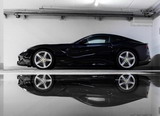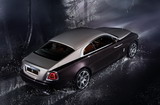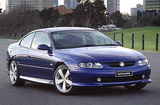Prodrive: ALS – Anti-Lag System and ATD – Active Torque Dynamics
The ALS on P2 is based on the system currently used on Prodrive’s Subaru World Rally Cars, but modified for use on the road. In tests, it has been shown to double engine torque at low revs, enabling a test car to accelerate from 30 to 50 mph in the same time in third gear as it would without the system in second gear.Turbo-charged engines tend to run with a rich fuel mixture and, as a result, some of this fuel remains unburnt and ends up in the exhaust. At low engine speeds, when turbo-lag is experienced, the anti-lag system can introduce ambient air into the red hot exhaust manifold causing this fuel to spontaneously combust. This increases the manifold pressure, spinning the turbo back onto boost. In the Subaru World Rally Car, this gives Petter Solberg instantaneous response throughout the Impreza’s rev range.
"Unfortunately, transferring the system to a road car was not as straightforward as it might seem," said Prodrive powertrain engineer, David Hemming. "In a World Rally Car, our drivers are either fully on or off the accelerator and not concerned about how smooth the power delivery is. For motorists this is definitely not the case and an unmodified system would provide an unacceptable driving experience."
Prodrive spent six months developing the system on an engine on a transient engine dynamometer at its Milton Keynes test facility. During this time engineers managed to achieve closed-loop control of the turbo boost and make it work in a road car application. The system is so refined that it can control the turbo speed to within one per cent at almost any engine revs. "The system is not ready for production yet, but it has shown great potential. It will make P2 far more flexible to drive as without the turbo-lag you don’t have to drop down a gear to get the acceleration you want," said Hemming.
As well as enhancing the performance of turbo-charged cars, in the longer term it could provide a solution to the downsizing of engines in cars and so help improve fuel economy and reduce emissions.
"With an anti-lag system, you could in theory replace a normally aspirated, two litre engine with a turbo-charged one litre engine. This would typically reduce fuel consumption by about 25 per cent without any loss in performance," said Hemming.
Prodrive is already talking to a vehicle manufacturer about the application of this system.
ATD – Active Torque Dynamics
P2 has been fitted with Prodrive’s ATD system. During the last five years, Prodrive has been developing this system and has already built 12 demonstrators for a variety of vehicle manufacturers for different applications on four, rear and front wheel drive cars, ranging from large SUVs to supercars. The principle of ATD is to keep a vehicle going where the driver wants it to go, by modulating the torque at the road wheels using active differentials rather than applying the brakes, as is the case with stability systems such as ESP.
"Road cars are generally driven in the ‘linear region’ where a certain input to the steering wheel results in a corresponding cornering rate of the car," said Damian Harty, chief engineer, dynamics. "However, when something unexpected happens, drivers tend to apply more steering angle than the vehicle can actually follow (around 10 degrees at the roadwheels). The vehicle behaviour changes significantly and the car does not go where the driver wants. This change is enough to confuse many people at a critical moment and often leads to loss of control in emergency situations. ATD extends this ‘linear’ region, making the vehicle much more controllable in emergencies."
ATD uses data from wheel speed sensors (which can be shared with the antilock braking system), a yaw rate sensor and a steering wheel angle sensor to compare what the driver is requesting with what the vehicle is providing. If the driver is accelerating, or has some throttle applied, a torque can be applied to the appropriate wheel to counter oversteer or understeer. If they are braking, or off throttle, the system can be integrated with a conventional stability programme and brake the opposite wheel to enhance directional stability while reducing vehicle speed. On P2, which is all wheel drive, the ATD system uses an active centre and active rear differential to modulate torque between the front and rear axles as well across the rear axle. Where appropriate, this allows the vehicle to enter a corner with the favourable dynamics of a rear-wheel drive car to minimise power understeer, then progressively increase torque to the front wheels as it moves around the corner. As the vehicle leaves the corner, the torque split can be biased towards the front wheels to provide maximum straightening force to help correct any oversteer or, alternatively, to help induce a powered drift.
With the active rear differential, P2 can also be given additional high speed stability for example in the event of an emergency lane change manoeuvre. By electronically controlling the lock on the rear differential, the car is provided with the agility to steer around an obstacle but then given added stability to help stop it spinning while returning to its path. Harty says that the system has significant benefits compared with conventional brake-based stability programmes: "ATD is extremely responsive. It can predict the vehicle’s reaction to changes before it calculates the correction required, so can achieve the required wheel speed in around 70ms. Because it applies positive torque, working with the movement of the car, it also feels more natural, particularly to performance-orientated drivers. A brake-based stability system can not distinguish when a driver is deliberately pushing a car to its limits and when a driver really is in trouble. As a result, it has to always assume the driver is in trouble and so intervenes when driving hard so ruining the driving experience."
In addition to P2, Prodrive has two dedicated ATD demonstrators: an all wheel drive system, similar to the P2’s, on a Subaru Impreza and a front wheel drive system fitted to a Ford Focus RS which helps correct torque steer. Both are available for test drives.











